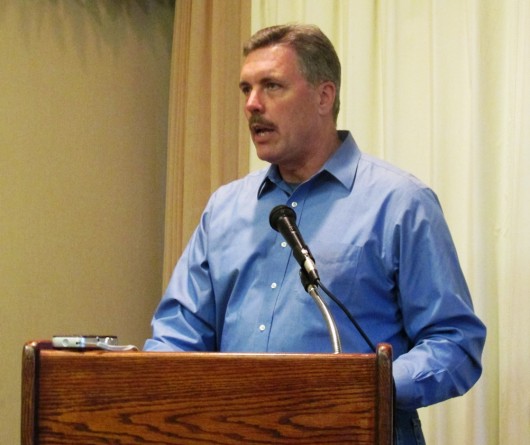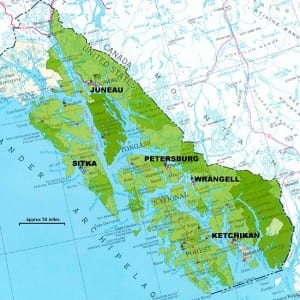
Tongass National Forest Supervisor Earl Stewart speaks at the Dec. 9 Chamber of Commerce lunch meeting.
New Tongass Forest Supervisor Earl Stewart has a bit of an uphill battle when it comes to gaining the trust of some Southeast Alaska residents. He listened to some criticism of the Forest Service on Wednesday during the weekly Ketchikan Chamber of Commerce lunch.
As the featured speaker, Stewart kept his main presentation positive, and said his focus is, and will be on stability for communities within the Tongass.
Stewart touched on the Draft Environmental Impact Statement for the Tongass Land Management Plan amendment, which was released for public comment recently, and says the plan will provide for a 16-year transition to young-growth timber harvest.
After his prepared statements, Stewart asked if anyone had questions. That’s when he heard some strong criticism of how the federal government has managed the Tongass.
Lloyd Gossman is a former Ketchikan Chamber of Commerce president, and says the U.S. Forest Service has lost its credibility, starting with the implementation of TLMP in the mid-1990s.
“I remember at the last meeting where one of these heads was, they said, ‘Well, we’re going
to have a TLMP here now with about 400,000 acres (for timber), and we’re not going to take it down any more,” he said. “That was on a Wednesday. Friday, the paper comes out and says, ‘Well, we decided to pull another 75,000 acres for HCAs, habitat conservation area. That dialogue has never changed to this day: Say one thing, do another.”
Gossman says the 17 million-acre forest should be turned over to the State of Alaska.
“I’m around to tell you that there’s a lot of guys like me around that say, the federal government out of the picture is the only way the Tongass National Forest will ever work again,” he said.
Stewart says it is challenging to balance all the interests involved with the Tongass National Forest, and timber is particularly challenging, in part because of environmental groups that file lawsuits to stop or slow planned timber sales.
Stewart says the proposed transition to young-growth timber should eventually help provide a stable supply of trees for the industry, without generating the level of protest that old-growth harvest inspires. He says logging will continue to be a key part of the multi-use forest system.
“That’s one component: The timber industry side of it,” he said. “If you can’t make that sustainable, and long-term and precise and accurate, you’re probably not going to help with the community aspect, which is a broader question of having the community stability.”
Following repeated assertions from Gossman that the forest be turned over to the State of Alaska, Stewart stressed that he believes the U.S. Forest Service is the best choice to manage the Tongass and to revive – at least in part – the timber industry.
Stewart says he’s struggled through a similar issue when he worked on the Coconino National Forest.
“The system I left in Arizona was completely collapsed and gone,” he said. “The cost associated with trying to rebuild that and bring it back was perceived as never possible, (but) resulted in the largest stewardship contract in the history of the Forest Service, up to 300,000 acres of timber harvest.”
Stewart says he understands that federal actions in the past have eroded trust in the Forest Service, but his job is to look forward, toward a sustainable future.
CoastAlaska member station KFSK has this Nov. 20 report on the Draft EIS.






